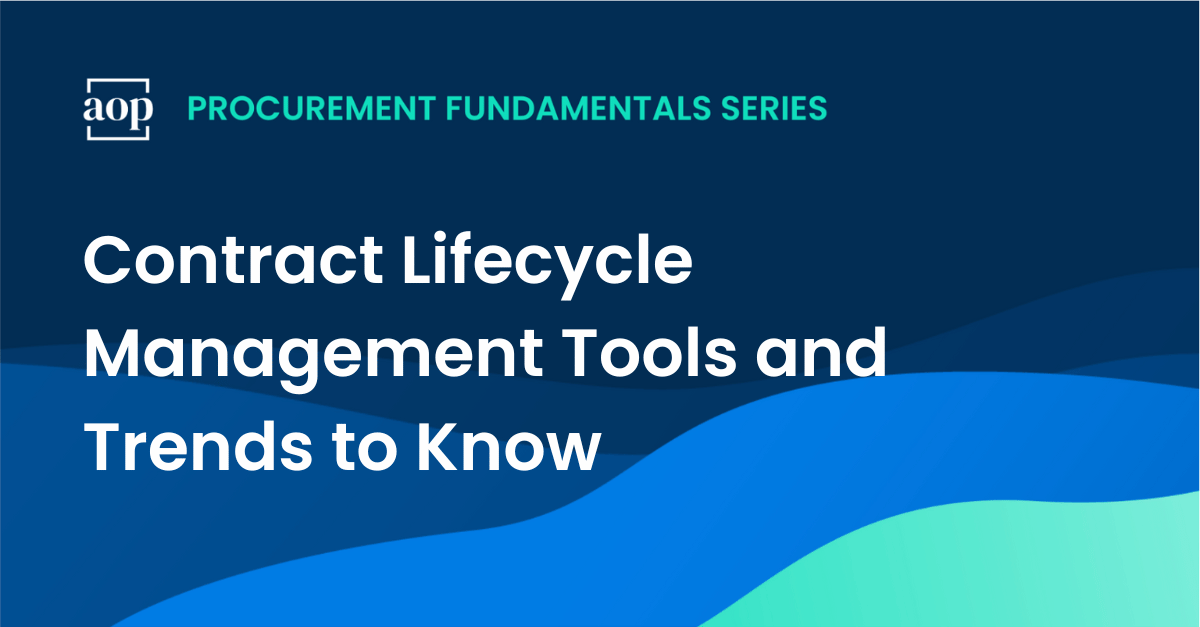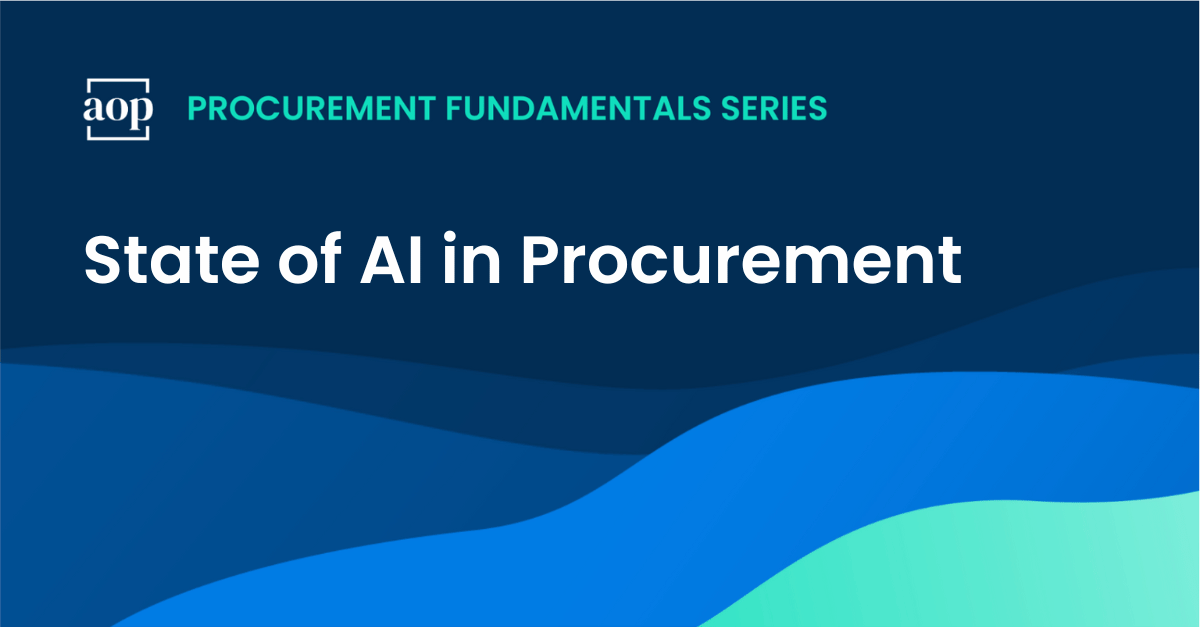6 min read
10 Contract Management Best Practices + Checklist for Procurement
Philip Ideson : February 21, 2025

Enterprise contract management can feel like an endless juggling act: you need to deliver speed, mitigate risk, align with company policies, and keep stakeholders happy. Even a single contract might draw input from legal, finance, IT, and operational teams—each with unique requirements.
The good news? A structured approach to contract management can reduce these headaches, reveal new cost-saving levers, and elevate procurement to a more strategic level. By focusing on ten core best practices, you can transform your contracts from “necessary paperwork” to tangible assets that empower the broader business.
Below, you’ll find an in-depth look at each practice, plus a concise checklist to help you put these strategies into action.
.png?width=1024&height=768&name=contract%20management%20checklist%20(aop).png)
1. Ensure legal + procurement alignment
Your legal and procurement teams often share the same ultimate goal: to protect the organization and secure the best possible commercial outcome,et their daily methods can differ sharply. Legal professionals concentrate on mitigating risk, ensuring compliance, and upholding enforceability. Meanwhile, procurement tends to focus on cost efficiency, speed, and supplier performance.
When you unite these complementary strengths, you create a single, powerful negotiation front. You’ll also ensure that each contract reflects a holistic view of business needs.
2. Treat contracts as strategic assets
Contracts can serve as roadmaps for how you and your suppliers work together. They do more than cement pricing or define service levels; they contain valuable data about obligations, risk exposure, and ongoing responsibilities.
You can view each agreement as a living document that shapes and reflects your organization’s strategic objectives on a forward-looking basis. One good approach is to embed contract obligations into project management milestones. This way you ensure that commitments remain top of mind for both internal teams and external partners.
3. Use risk as a negotiation lever
Procurement professionals often concentrate on price and delivery timelines—yet risk allocation can be just as impactful to the overall value of a deal. If you’re taking on more than your fair share of liability, consider negotiating for better pricing or additional service guarantees.
By incorporating risk-related questions in contract negotiations, you can pinpoint areas where the suppliervendor might concede on price or scope in exchange for shifting liability to your organization. This approach turns risk into a bargaining chip, instead of letting it become an afterthought.
4. Move beyond the digital filing cabinet
E-signature tools are a step up from storing contracts in filing cabinets, but saving PDFs to a shared drive can still leave you digging through scattered documents. In the worst case scenario, category managers might not even realize a contract is up for renewal until it auto-renews under unfavorable terms.
Migrating from static PDF storage to a contract management system (or at least a centralized, systematically labeled repository) changes the game. When each contract has clear metadata—like effective dates, notice periods, or performance criteria—you can quickly identify which relationships need immediate attention. This data-driven approach prevents you from needing to scramble at the last minute and avoids unpleasant surprises.
5. Make contracts central to ongoing supplier relationships
A contract shouldn’t vanish once it’s signed. In fact, its real utility begins after execution. When you keep track of the contract’s obligations, milestones, and service level agreements, you can catch performance issues earlier and can course-correct more efficiently.
Rather than seeing the contract as a backward-looking reference point, keep it visible during routine check-ins with your suppliers. If a supplier is falling short on promised metrics, addressing it early often preserves trust and helps both parties stay on track.
6. Collect and analyze content and process data
Contract data typically falls into two categories: content and process. Content data includes everything in the contract itself—clauses, obligations, renewal dates, and termination conditions. Process data tracks how each contract is created, negotiated, and approved: the number of redline rounds, average response times, or which departments delay sign-off most frequently.
Combining these data types provides a panoramic view of your contract ecosystem. You see not only what’s agreed upon, but also how those agreements come to life. This knowledge allows you to streamline approvals, forecast workload, and spot areas of excessive negotiation time. By analyzing both content and process metrics, you can refine templates, accelerate cycle times, and introduce best practices that truly stick.
7. Implement a contract lifecycle management platform
Relying on ad-hoc systems—email threads, versioned Word documents, and SharePoint folders— can lead to confusion in growing procurement organizations. A contract lifecycle management (CLM) platform brings transparency and efficiency by automating core steps in creation, approval, and archival.
Modern CLM tools can also integrate with existing systems like ERP, e-signature, and supplier management software, keeping your contract data in sync across departments. When you roll out a CLM properly, you reduce repetitive tasks, speed up sign-offs, and enable robust reporting on both active and archived agreements.
8. Embrace AI for efficiency—but avoid the hype
Artificial intelligence (AI) has become a buzzword in contract management. Indeed, advanced features like automatic clause detection or risk-flagging can dramatically reduce manual labor. However, AI isn’t a cure-all.
You still need human judgment for complex trade-offs and nuanced negotiations. AI can provide a solid starting point, suggesting fallback positions or identifying potential pitfalls. Ultimately, a balanced approach pairs the speed of AI with the contextual knowledge that only you and your colleagues possess.
9. Clarify roles and thresholds in your workflow
One of the biggest obstacles to speedy contracting is confusion over sign-off authority. You need a clear matrix that specifies exactly who signs off on different contract types and thresholds.
Defining these authority levels also helps your CLM or workflow system automatically route documents to the right people. When managers understand the rationale behind each threshold (e.g., high-value deals, data-sensitive agreements, strategic supplier partnerships), they become more comfortable trusting the process rather than seeking endless re-approvals.
10. Measure ROI and refine continuously
Contract management is never “done.” Each completed deal informs your future negotiations, template updates, and workflow improvements. Measuring ROI can be as straightforward as tracking how many days you shave off your average contract cycle or how many missed renewals you avert.
You might want to schedule periodic reviews to assess whether your contracting approach remains aligned with organizational goals. Over time, continuous improvement not only increases internal trust but also cements procurement’s credibility as a strategic function.
Your contract management checklist
- Ensure legal + procurement alignment: Align priorities and share a unified perspective in negotiations.
- Treat contracts as strategic assets: Reference them for performance insights, not just disputes.
- Use risk as a negotiation lever: Offset higher risk with more favorable pricing or terms.
- Move beyond the digital filing cabinet: Store contracts systematically with searchable metadata.
- Make contracts central to ongoing supplier management: Embed obligations into routine supplier reviews.
- Collect and analyze content and process data: Gain insights on both what you negotiate and how you do it.
- Implement a contract lifecycle management platform: Automate approvals and maintain version control.
- Embrace AI for efficiency—but avoid the hype: Let AI handle data-heavy tasks while you focus on strategic elements.
- Clarify roles and thresholds: Define who signs what and why to avoid confusion.
- Measure ROI and refine continuously: Track metrics, gather feedback, and continuously improve your process.
Key insights from Art of Procurement Episode 704 featuring Paul Bagley and Toby Laforest
If you’d like to hear how other practitioners approach digital contract management, you can tune in to Art of Procurement Episode 704: “The Future of Digital Contract Management w/ Paul Bagley and Toby Laforest.”
Below are some key quotes from Paul Bagley, Director of Commercial Contracting at Acosta, that illustrate how legal and procurement teams can collaborate effectively:
- On the value of combining legal and procurement:
“It really makes sense to me to have legal and procurement joined at the hip and having both legal and business terms negotiated fluidly and together, with one voice to the vendor.”
Paul underscores that legal and procurement aren’t adversaries—they should partner to create holistic, enforceable contracts. When you unite cost, speed, and risk perspectives, you minimize post-signature surprises. - On the importance of structured contract data:
“When you save a contract to a drive, it’s still essentially lost. The only person who knows it’s there is the one who put it there.”
Paul warns that simply scanning and storing PDFs doesn’t solve your visibility problem. Organizations need to convert contracts into living documents by capturing metadata and obligations in a shared system. - On using risk as a negotiation tool:
“There are three different levers in most negotiations—price, speed or functionality, and risk. If you’re bearing more risk, the other side should be giving you a better price.”
Instead of treating risk as an afterthought, Paul advises leveraging it as part of the value equation. Aligning price with risk distribution can lead to more balanced contracts and fewer conflicts down the road. - On aligning contracting processes with business demands:
“You need to map out your workflow first... If you can hand the full process map to your CLM partner, they can build it in weeks, not months.”
Paul highlights that a CLM implementation only goes smoothly if you define intake forms, approval pathways, and template rules in advance. The technology automates your process—it can’t create one for you from scratch.
These insights reflect what happens when experts meld their legal and procurement perspectives. You’ll find even more guidance in the episode itself, including a take from Toby Laforest, Director of Product Marketing at Ironclad, on the role of AI and how organizations can reduce the barriers to adoption.
Bottom line on enterprise contract management
Contract management is more than a bureaucratic hurdle—it’s a strategic function in the enterprise that can save you money, minimize risk, and improve supplier relationships.
When you build robust processes, collect valuable data, and leverage technology wisely, you elevate procurement’s role beyond simple cost-cutting. Each time you reduce cycle times, prevent auto-renew mishaps, or recover missed credits, you prove that carefully managed contracts deliver tangible value to the entire organization.
With the right mindset and resources, your contract management framework can fuel the efficiency and innovation that positions your company—and procurement itself—for sustained success.
If you’re looking for more tips, expert views and best practices, head on over to our Contract Lifecycle Management Technology Hub.




.png)

